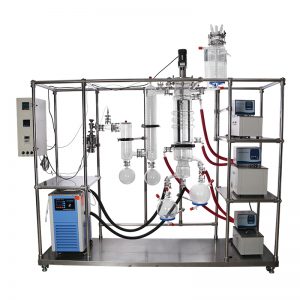As a kind of distillation technology, the molecular distillation should be carried out under a high vacuum condition. Because the average free path of steam molecules is greater than the distance between the evaporation surface and the condensation surface, the liquid mixtures can be separated by utilizing the difference of the evaporation rate of each component in the liquid.

Working Principle of Molecular Distillation
- The molecules diffuse from the main body of the liquid phase to the evaporation surface: Generally, the diffusion velocity in the liquid phase is the main factor controlling the molecular distillation rate. Therefore, reduce the thickness of the liquid layer and enhance its flow.
- The molecules freely evaporate on the surface of liquid layer: The evaporation rate increases with the increase of temperature, but the separation rate sometimes decreases with the increase of temperature. Hence, the economical and reasonable distillation temperature should be selected on the premise of the thermal stability of the processed material.
- The molecules fly from the evaporation surface to the condensing surface: In this process, the steam molecules may collide with each other or with the gas molecules remaining between the two surfaces. The steam molecules are much heavier than air molecules, and most of them have the same movement direction, so their own collision has little influence on the flying direction and evaporation rate. The residual gas molecules are in the state of chaotic thermal motion between the two surfaces, so the number of residual gas molecules is the main factor influencing the flying direction and evaporation rate.
- The molecules condense on the condensing surface: It is considered that the condensing step can be completed instantly as long as there is enough temperature difference between the hot and cold sides ( generally 70~100℃) and the form of the condensing surface is reasonable and smooth. So It is pretty essential to choose a reasonable condenser form.

Conditions of Molecular Distillation
- The partial pressure of the residual gas must be quite low so that the average free path length of the residual gas is a multiple of the distance between the distiller surface and the condenser surface.
- The average free path length of the steam molecules must have the same order of magnitude as the distance between the distiller surface and the condenser surface under the saturation pressure. (Average free path: It refers to the statistical average of the distance traveled by gas molecules during the time between two collisions.)
Evaporation & Distillation & Rectification
Evaporation is a unit operation process, while both distillation and rectification are the combination of evaporation and condensation unit operations. Rectification differs from distillation in that it requires reflux. When the reflux is involved in the distillation process, distillation turns into a simple rectification. Both distillation and rectification are used for purification. Distillation can be adopted to purify cleaner mixtures with simpler components, while rectification is adopted to purify complex mixtures with muti-components. The rectification equipment is complex and high energy consumption.
[title text=”Related Products” tag_name=”h2″ color=”rgba(32, 163, 219, 0.81)”]
[ux_products columns=”2″ ids=”973,21474″]
[title text=”Related Posts” tag_name=”h2″ color=”rgba(32, 163, 219, 0.81)”]
https://www.rotovap.cn/rotary-evaporator/1444.html
